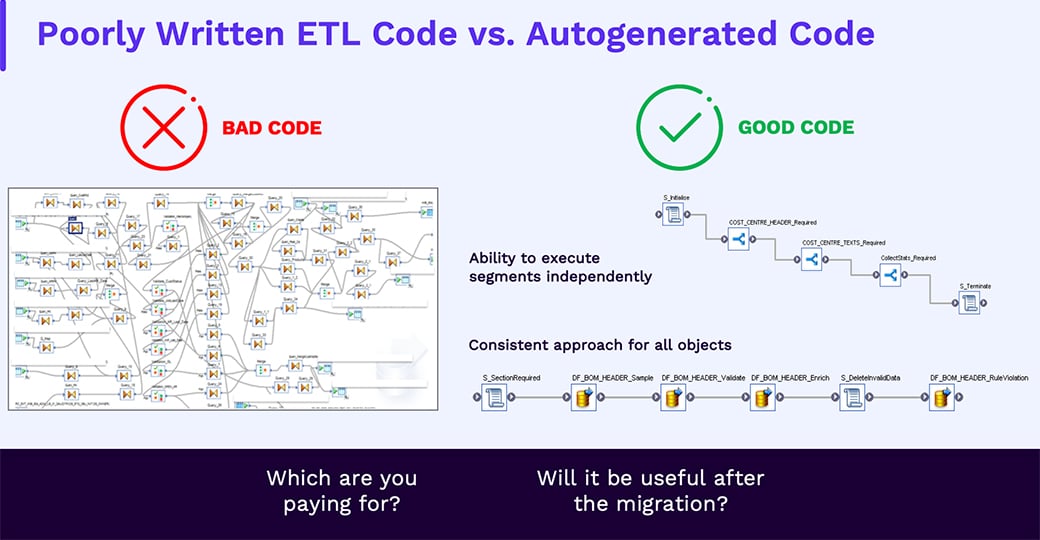What to Look for in Data Matching Solutions
Choosing a data matching software is more than storing your data in a warehouse or CRM. Data matching solutions should intelligently analyze your...
When choosing to spend money on data migration, be sure to choose a solution that sets you up for success and streamlines every step in the process.
One reason data migrations don’t deliver on value is poorly written code. Think of it this way - an ETL tool is a programming tool. For someone with less programming experience, it’s easy to mistakenly create a lot of really bad code.
The migration engine we use at Syniti autogenerates good code based on standard templates and best practices, making it easier to maintain, debug, and deploy. This autogenerated code takes out the complexity scale required to use the tool on its own.
Look at the example below of an actual data services job. What would be more useful after a migration? The clean, intuitive approach on the right is obviously going to result in reusable rules for ongoing data quality and data management activities post-migration.

Without ADMM, we lose all ability to automate and capture things like mapping, adding data that’s missing from our data sets, or documenting rules that need to be created.
What’s left? Most often, it’s Excel. We've seen customers trying to document really complex migrations with literally 5,000 or more spreadsheets. With spreadsheets that get emailed around and updated, there is no change control process. Users are left wondering if they have the current version or if what’s written in the code actually reflects the rules in the spreadsheet. It’s nearly impossible to determine.
In this manner, there is no one version of the truth nor project control for the work being done to deliver the migration.
With ADM, there is complete tracking and visibility for every rule, every step, and everything consultants are doing in the tool. When things come up, you’re able to quickly make course corrections, put more resources where they’re needed, and if needed, change the scope of certain deliverables - all while making sure that the business goals are achieved.
Due to this level of project predictability, Syniti customers consistently experience a positive ROI in under 12 months. What’s more, they have confidence that their migration projects will be done right the first time, on time.
Whether you’re moving to the cloud or implementing S/4HANA, you can drastically decrease the level of investments needed by right-sizing your migration data payload. Why move all your data if you only need a subset of that to run? Thinking about right-sizing your data ahead of time helps to decrease the costs and risks associated with that deployment.
Not doing so results in a lot of missed, valuable opportunities. For example, archiving off that data in a way that is approved by your auditors. You may be able to decommission legacy systems and remove extra operational costs from the environment that IT is responsible for.
Deduplication of data and making sure you have streamlined datasets is another opportunity missed with ETL. In the case of S/4HANA, for example, you need to understand how to do business partner harmonization. If you’re going to merge all your customers and suppliers and vendors into one system, you want to make sure there are no duplications, and it's simplified and streamlined to run the business. This will make it much easier to manage that critical master data even after the migration.
Improvements in master data and transaction data quality is something we focus on a lot at Syniti in order to execute business processes flawlessly. When delivering a migration, we hit 99.9% or better data quality levels, versus what is typically achieved with a stand-alone data quality tool. Poor Data Quality impacts a customer's investment in their new system and the expected business benefits.
Conclusion
If you’re going to spend the money on data migrations, don't waste valuable dollars on ETL software that on its own, is incapable of ensuring success and maximizing the value for business-as-usual operations.
Syniti Knowledge Platform streamlines every step in the data migration process with solutions like data integration and replication, data harmonization and matching, and data quality.
The recommended solution of choice for all RISE with SAP programs, SAP Advanced Data Migration by Syniti has a proven history of reducing migration costs by 38% on average. SAP Advanced Data Migration optimizes software and services spend with business value pre- and post-migration.
Don't flush investments in technology, infrastructure, and resources down the toilet. Let’s use it, let’s capture it, and let’s make sure the next project or next migration is even cheaper, faster and delivers more value.
Kickstart your data migration process with the enterprise-grade software that keeps that value going even after the migration is over. Ask about how Syniti’s compendium of features and solutions can be purpose-fit for your specific needs today.
Choosing a data matching software is more than storing your data in a warehouse or CRM. Data matching solutions should intelligently analyze your...
Use the data migration guide's 8 steps to implement SAP best practices for your next project.
Before exploring some of the common risks and benefits associated with data migration, let’s start with establishing first what migration is and how...